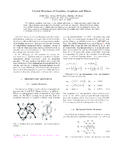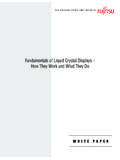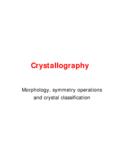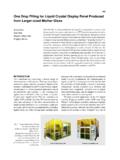Transcription of zeolite atlas web - IZA Structure
1 atlas of zeolite Framework TypesFifth Revised Edition20012 SummaryIntroduction Books of the International zeolite Association (IZA) Availability History of the atlas of zeolite Framework Types Organisation of the AtlasExplanatory Notes from the atlas of zeolite Framework Types Examples LTA LTL Other framework types (if appropriate)3 International zeolite Association (IZA)Books from the Structure CommissionIntroduction4 AvailabilityPrinted VersionElectronic Version (pdf-Files) of the atlas of zeolite Framework TypesIntroduction13320015th9819964th8519 823rd3819782nd2719701stZeolite StructuresYearEdition6 History of the atlas of zeolite Framework TypesChange of name for the atlas recommended by IUPAC in 2001 Old : atlas of zeolite StructureTypesNew : atlas of zeolite FrameworkTypesIntroduction- Structure : Implies both, the framework and extra-framework constituents-Framework: Corner-sharing network of tetrahedreally coordinated atoms7 Organisation of the AtlasTwo pages in the atlas for each framework type codeIntroductionLeft pageFramework Type Informations Framework type code Stereographic figure Idealized cell constants Coordination sequences Vertex symbols Secondary building units Loop configurations of T-atoms Framework description Isotypic framework structures ReferencesRight pageType Material Informations Crystal chemical data Framework density Channels (observed rings) Stereographic figure (channels)8 Left PageFramework Type Informations9 Framework Type CodePreviously called Structure Type CodeThree capital letters (IUPAC Commission on zeolite Nomenclature, 1978)Usually derived from the name of the type materials (Appendix D in the atlas )For interrupted frameworks the 3-letter code is preceded by a hyphen (-)
2 For intergrown materials, the *denotes a framework of a hypothetical end memberCodeAbbreviated NameFull Name LTAL inde Type AZeolite A(Linde Division, Union Carbide) LTLL inde Type LZeolite L(Linde Division, Union Carbide) FAUF aujasite MFIZSM-5 (five) zeolite Socony Mobil five -CLOC loveriteFour-leafed clover shaped pore opening *BEAZ eolite BetaNotes and Examples10 Framework Type CodeCodes are only assigned to established structures that satisfy the rules of the IZA Structure Commission (Rules can be found in Appendix B)The codes should not be confused or equated with actual materials. They only describe and define the frameworkNot allowed: NaLTA, NaLTL, NaFAUC orrect is to use: | | for guest species, [ ] for framework host |Na+12(H2O)27|8[Al12Si12O48]8-LTA or|Na| [Al-Si-O]-LTA |K+6Na+3(H2O)21| [Al9Si27O72]-LTL or|K-Na| [Al-Si-O]-LTL |Na58| [Al58Si134O384]-FAU or|Na| [Al-Si-O]-FAUF ramework types do not depend on composition, distribution of the T-atoms, cell dimensions or symmetry (T-atoms: Si, Al, P, Ga, B, Be, etc.)
3 Notes and Examples11 LTA: Structure and Framework FiguresNotes and Examples12 LTA Framework: Stereographic FigureNotes and Examples13 LTL: Structure and Framework FiguresNotes and Examples14 LTL Framework: Stereographic FigureNotes and Examples15 Idealized Cell ParametersThey are obtained after geometry refinement in the highest possible symmetry for the framework typeRefinement was carried out assuming: Hypothetical SiO2composition dSi O= dO O= dSi Si= Notes and Examplesa = c = P6/mmmHexagonalLTLa = Pm-3mCubicLTACell ParametersSpace GroupCrystal System16 Coordination Sequences (CS)Each T-atom is connected to N1= 4 neighboring T-atoms through oxygen bridgesThese neighboring T-atoms are then linked in the same manner to N2T-atoms in the next shellEach T-atom is counted only onceInfinite, ideal case without T-atom sharing:N0= 1 N1= 4 N2= 12 N3= 36 N4= 108 Listed in the atlas for every T-position: Multiplicity and site symmetry of the position CS from N1up to N10 Notes and Examples17 Coordination Sequence for LTAT1 (24, m) 491728 42 60 81 105 132 162 Notes and Examples18 Coordination Sequences for LTLT1 (24, 1) 491729 46 69.
4 T2 (12, m) 4102135 49 66 ..Notes and Examples19 Vertex SymbolsThe vertex symbol indicates the size of the smallest ring associated with each of the 6 angles of a tetrahedron (T-atom)The symbols for opposite pairs of angles are grouped togetherRings of the same size at a vertex are indicated by a subscriptNotes and ExamplesLTAT14 . 6 . 4 . 6 . 4 . 8 LTLT14 . 4 . 4 . 6 . 6 . 8T24 . 83. 4 . 83. 6 . 1220 Vertex Symbol for LTA4 . 6 . 4 . 6 . 4 . 8 Notes and Examples21 Vertex Symbols for LTL4 . 4 . 4 . 6 . 6 . 84 . 83. 4 . 83. 6 . 12 Notes and Examples22 Secondary Building Units (SBU) zeolite frameworks can be thought to consist of component units: Finite ( chain-like) Infinite ( layer-like)The finite units which have been found to occur in tetrahedral frameworks are called Secondary Building Units (SBU)The primary building units are TO4tetrahedraSBU are derived assuming that the entire framework is made up of one type of SBU onlyIf more than one SBU is possible, all are listedNumber in ( ) = frequency of occurrenceNotes and Examples23 Secondary Building Units for LTA8or 4-4or 6-2or 4-2or 4 Notes and Examples24 Secondary Building Units for LTL8or 6 Notes and Examples25 Loop Configuration of T-atomsSimple graph showing how many 3- or 4-memberd rings a given T-atom is involved inCan be used for classification purposesInformation given is a subset of the vertex symbolSolid lines: T O T linkDotted lines.
5 T O bond found in interrupted frameworksNumber in ( ) = frequency of occurenceNotes and Examples26 Loop Configuration of T-atom for LTAN otes and Examples27 Loop Configuration of T-Atoms for LTLN otes and Examples28 Framework DescriptionFor all 15 framework types of the so-called ABC-6-family the ABC stacking sequence is listedAFTN otes and ExamplesListed are also some other structural relationship which are thought to be helpfulFAU29 Isotypic Framework StructuresAs-synthesized materials that have the same framework type but different chemical compositionMaterials with different laboratory codeMaterials obtained by post synthesis treatment ( in exchange, dealumination) are generally not includedThe type material, the species first used to establish the framework type, is given first and marked with an asteriskNotes and ExamplesLTALTL30 zeolite Type Categories and Framework Type GroupsZeolite type categories Silicates PhosphatesFramework type groups Silicates Phosphates Both, silicates and phosphatesNotes and Examples31 ReferencesIs not a complete listAs general rule, references are given to.
6 Work to type of materials first establishing that framework type Subsequent work adding significant information regarding the framework topologyReferences to isotypes are limited to the work in which sufficient data are provided to establish the identityNotes and Examples32 Right PageType Material Informations33 Crystal Chemical DataComposition, expressed in terms of cell contents (New IUPAC rules are used)Crystal system, space group and cell parametersRelationship of the unit cell orientation with respect to the framework type, if the space group setting of the type material differs from that of the framework typeNotes and Examples34 Framework Density (FD)The framework density is a simple criterion for distinguishing zeolites and zeolite -like materials from denser materialsDefinition:The figures given refer to the type materialsNon-zeolitic framework structures: FD = 20 21 zeolite with fully crosslinked frameworks: FD = s less than 12 have only been encountered for the interrupted framework of cloverite (-CLO)The FD is obviously related to the pore volume but does not reflect the size of the pore openingsNotes and Examples 1000 Atoms-T of Number335FD vs.
7 Smallest Ring in Loop ConfigurationThe +sign indicates that there are some T-positions associated with only larger ringsLTA Smallest ring size: 4 FD = Smallest ring size: 4 FD = Smallest ring size: 4+ FD = and Examples36 ChannelsShort notation for description of channelsChannel direction, relative to the axis of the type material Structure <..> : All symmetry related directions [..] : Only given direction [..] : Channel direction is at right angle to the given directionNumber of T-atoms forming the ring (in bold type)Free diameters of the channels in Number of asterisks (*): Channel is one- two- or three-dimensionalDouble arrow ( ): Interconnecting channel systemsA vertical bar ( | ): No direct access frome one channel system to the otherNotes and Examples37 LTA: Channel<1 0 0> x **Notes and Examples38 LTL: Channel[0 0 1] x *Notes and Examples39 OFF (Offretite): Channels[0 0 1] x * [0 0 1] x **Notes and Examples40 RHO ( zeolite Rho): Channels<1 0 0> x ** | <1 0 0> x **Notes and Examples










